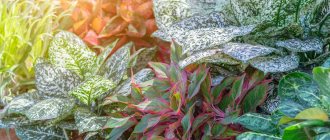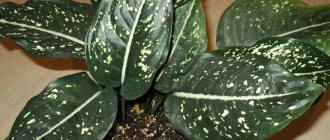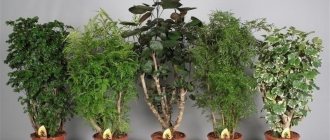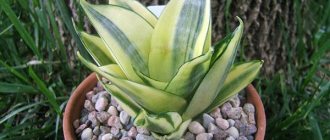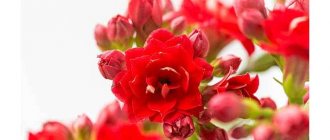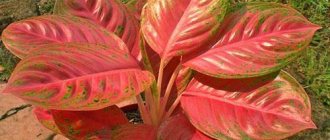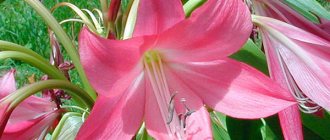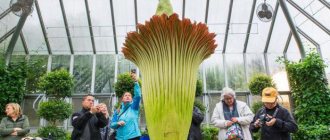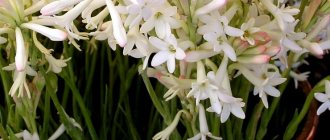Indoor plants not only serve as interior decoration, but also create a special atmosphere in the house. Many people believe that flowers grow and develop well only in an apartment with a good energy background. In fact, they require proper care and aglaonema is no exception.
In order for the plant to develop and please its owner, it is necessary to comply with growing standards. This article describes 12 basic rules that will help beginners grow a beautiful and healthy “beauty”. I tried my best for you, from my own experience, so save the page on social networks.
Transfer
Purchased specimens are replanted only after 1–2 weeks. During this period, the bush will adapt to the microclimate of the apartment, and at the same time it will pass quarantine. Transport soil is not the best environment for a seedling, but it is better to wait the allotted time and take your time.
Subsequently, aglaonema is replanted annually up to 3-4 years, older bushes once every 4-5 years.
How to understand that a flower needs a transplant:
- no annual growth;
- roots protrude above the soil surface and into drainage holes;
- water after watering does not go deep into the pot for a long time;
- the flower has a sickly, pale appearance;
- More than 4 years have passed since the transplant.
Note! The juice and berries of the plant are poisonous. When working with flowers, you must use gloves and wash your hands thoroughly.
Step by step transplant process:
- The bush is watered the day before transplanting. If a complete replacement of the soil is required, there is no need to water.
- A 2–4 cm drainage layer and a little nutritious soil mixture are poured into the new pot.
- Remove the flower from the old pot, trying not to break the earthen lump. If replacement is needed, the old soil is carefully shaken out from the roots.
- Next, install it in the center and little by little fill it with new soil.
- The pot is shaken periodically so that the soil fills all the voids.
- If support is needed, it is placed before filling the soil.
- The depth of the barrel is left at the same level.
The flower is watered and placed in partial shade for adaptation. After a week, the bush is returned to its usual place.
Description of Aglaonema
The home flower Aglaonema is an evergreen herbaceous plant. The short and straight stem is quite fleshy. There are species in which the trunk begins to branch at the base.
Aglaonema nitidum
The stem is present only in mature plants, and its formation occurs due to the flight of the lower leaf plates. The color of the foliage directly depends on the type and variety of the plant. The shape of the dense, leathery leaf plates to the touch is ovoid or lanceolate. They are attached to the trunk by petioles, which can be long or short.
The edge of the leaves is solid, while the plate is patterned, and on its front surface there is a depressed midrib, while on the reverse side it is convex. At the top of the plant, from the axils of the leaves grow from 1 to 3 ears with a greenish-white cover; they are the inflorescences of aglaonema.
Depending on the type of plant, the cobs are divided into 2 types:
- thick club-shaped - reach 10 mm in diameter and their length is 40 mm;
- thin cylindrical - their length is about 60 mm, and their diameter reaches 5 mm.
The fruit is a juicy berry, inside of which there is 1 seed, which has a rich orange or white color. The berries ripen after 6–8 months.
Aglaonema Blooming
Choosing a pot and preparing the soil
A stable, wide, but not too deep pot with drainage holes and a tray is suitable for planting. Flower growers advise using containers made of plastic or coated ceramic. The diameter of the new pot should exceed the old one by only 2–3 cm.
A pot that is too large will result in the aglaonema taking a long time to grow roots, and the green mass will stop developing.
Aglaonema is undemanding to the composition of the soil, but the soil must be loose and nutritious. For planting, a purchased soil mixture for decorative foliage and bulbous plants is suitable. You can mix the soil yourself, observing the proportions.
Soil composition:
- 3 parts leaf soil;
- 1 hour humus;
- 2 parts of river sand, poured or vermiculite;
- 2 hours peat;
- charcoal.
A drainage layer of expanded clay, broken brick, polystyrene foam or small gravel must be added to the pot.
The soil
The soil must retain moisture well and be breathable.
You can buy ready-made soil, for example, for violets, bulbous plants, azaleas or heather.
But you can prepare the soil yourself: garden soil - 1 part, coarse sand or perlite - 1 part, peat or leaf soil (humus) - 2 parts.
For young plants, the following composition is suitable: leaf soil - 2 parts, sand, turf soil, peat - 1 part each.
The plant does not like stagnant water, so the pot must have good drainage , for example, a layer of expanded clay, and there must be holes in the flowerpot itself.
Lighting, choice of location
In its natural environment, aglaonema grows in the shade of large plants, so it is better to place the pot in partial shade in the house. The flower is light-loving, but direct rays are destructive to delicate leaves and can leave burns on them.
Note! Purchased specimens cannot be immediately placed on the windowsill. They need adaptation to natural light within 1–2 weeks.
The ideal place for the pot would be an eastern or western window sill. On the south window you will have to shade it with tulle, larger plants or place it at a short distance from the light source.
Variegated varieties turn pale from lack of light and lose color, becoming monochromatic.
Possible problems during cultivation
Pests common to indoor plants may appear on aglaonema:
- thrips;
- spider mites;
- scale insects;
- scale insects;
- rarely - aphids or whiteflies.
For control, insecticides are used, for example, Aktelik. If owners want to use new odorless preparations, when fighting spider mites, they need to make sure that they have an acaricidal effect. This is not an insect, but an arachnid.
Of the diseases, the most dangerous are rot:
- root when growing aglaonema in dense soil, without drainage or lower holes in the pot;
- leaves arising due to the transfer of fungus from other plants, or spraying at low temperatures.
They get rid of infections of the aerial parts by treating them with appropriate fungicides. If the root begins to rot, you will have to root the top.
Other problems:
- leaves curl - cold;
- the plates are wrinkled - dry air;
- brown tips - the same;
- whitish spots on the leaves – sunburn;
- dark marks on the plates are the result of waterlogging of the soil;
- the bush turned black - hypothermia.
Watering schedule, air humidity
Aglaonema is sensitive to the composition of water. To water it, it is better to use warm, filtered, bottled or settled water. Increased rigidity will lead to loss of decorativeness.
During the growing season, the flower is watered only when the top layer of soil has dried out 3–4 cm deep. But it is worth considering that flooding is just as harmful as drought and monitoring the condition of the earthen clod and roots. At this time, the leaves are sprayed daily, and expanded clay, pebbles or moss are poured into the tray, which are regularly moistened.
During dormancy, watering is reduced to once a week, but only if the plant is kept in a room with a temperature no higher than +16 °C. If the flower does not “fall asleep,” then the watering schedule remains the same.
Reproduction
The plant reproduces well in almost all popular ways: cuttings, seeds, root division.
Propagation by Agloanema cuttings
Propagation by cuttings
Reproduction in this way is best done in the spring. The apical cutting cut off during pruning can be used for propagation. To do this, divide it into several parts 10-15 cm in length, so that each part has leaves.
Treat the cut areas with crushed charcoal. Leave the cuttings in the fresh air for a day to dry. Then place the planting material in a container with a damp substrate (consisting of peat and sand), deepening it to 5 cm.
It is recommended to cover the cuttings with a transparent bag or glass lid to create greenhouse conditions. Place the container in a warm place with a temperature of 22-25 degrees. Do not forget to ventilate the greenhouse and, if necessary, moisten the substrate.
In about a month, the cuttings will give roots. When this happens, transplant them into separate pots filled with soil for adult plants, and care for them according to all the rules for caring for aglaonema.
Growing from seeds
Aglaonema from seeds
This method does not guarantee the preservation of the varietal characteristics of the parent specimen. Aglaonema seeds can either be bought in a store or obtained independently, because it happens that the plant self-pollinates.
In this case, after inconspicuous flowering, fruits in the form of berries are formed on your flower. Their color can be any shade from yellow to red, depending on the variety.
Do not pick the berries until they are ripe. The pulp of the fruit contains seeds. Once ripe, remove them and rinse well with water.
Just don't wash them over the sink, otherwise you risk losing the planting material, which can easily slip through your fingers.
We recommend sowing the seeds immediately, as they quickly lose their viability. Fill the container with a mixture of peat and sand in proportions 1:1, water it, and sow the seeds into it. Place the container in a warm place and wait for the shoots to appear. They will appear relatively quickly.
As soon as the first true leaves appear on them, pick the seedlings into separate cups. When they grow up, they can be transplanted into separate pots with substrate for adult specimens.
They will become full-fledged fluffy bushes after 3-4 years.
Reproduction by root division
Reproduction of aglaonema by root division
Adult, strongly grown specimens with a healthy and well-developed root system are suitable for this method of propagation. It is convenient to propagate aglaonema by dividing the root during transplantation.
- After removing the bush from the pot, shake off the earthen lump, rinse the roots with water and carefully inspect them. Remove damaged areas, if any.
- Using a sharp knife or scissors, divide the rhizome into the required number of parts so that each of them has healthy shoots and at least 3 leaves.
- Sprinkle the cut areas with crushed activated charcoal or charcoal.
- Plant each of the resulting specimens in pre-prepared pots according to the rules specified in the “Transplanting” paragraph, water well.
- Place in a warm place, water and spray.
- Evidence that the plant has taken root normally and is not diseased will be the appearance of young leaves. Then you can put the pot in a permanent place.
Fertilizers and fertilizers
It needs to be fed only during the growing season, which lasts from March to August. Any complex composition containing nitrogen and potassium is suitable.
I recommend watching the video (be sure to watch it to the end), you will learn a lot of new things:
Note! Store-bought fertilizers often contain harmful components, so some gardeners prefer to use their own recipes .
Feeding:
- Mineral water (slightly carbonated, non-carbonated) will help nourish the flower with beneficial microelements. You can water it with soda once a week.
- Unsalted vegetable broth from any root vegetables. Can be used 2 times a week, actually replacing regular watering.
Complex mineral supplements:
- ETISSO fertilizer for indoor plants in the form of sticks. The complex contains nitrogen, phosphorus, potassium, magnesium, iron, copper, zinc. The stick is stuck into the soil and during watering it slowly dissolves and saturates the soil with useful substances. One stick is enough for a month.
- BONA FORTE is a liquid, concentrated fertilizer for decorative foliage plants. Contains phosphorus, potassium, magnesium, succinic acid, nitrogen, zinc, copper and other trace elements. For root feeding, dilute 10 ml/1.5 liters of water at the rate of 0.5 liters per bush. For spraying 5 ml/1.5 liters. The interval between procedures is 14 days.
Signs associated with flowers
Aglaonema is believed to bring good luck to its owner. This is connected with the story of a large cash prize: a man looked at the numbers on the leaves of aglaonema in the garden, indicated them when buying a lottery ticket and won.
In addition, aglaonema is believed to increase performance and concentration. Scientists say that its leaves purify the air and can destroy streptococci.
Sources and literature
Sources and literature
- Botany. Encyclopedia “All the Plants of the World”: Trans. from English / Ed. Grigorieva D. et al. - Könemann, 2006 (Russian edition). — P. 68-69.
- D. Hessayon. All about indoor plants. - M.: Kladez-Books, 2001
- Grudzinskaya I. A. The arum family (Araceae) // Plant Life. In 6 t / Under. ed. Takhtadzhyan A.L. - M.: Education, 1982. - T. 6. Flowering plants. — P. 471.
- Houseplants / T. M. Klevenskaya // Great Soviet Encyclopedia: [in 30 volumes] / ch. ed. A. M. Prokhorov. — 3rd ed. - M.: Soviet Encyclopedia, 1969-1978
- Saakov S.G. Greenhouse and indoor plants and their care / Under. ed. Kamelina R.V. - L.: Nauka, 1983. - P. 132-134. — 621 p.
Anti-aging pruning
As the trunk grows, it gradually becomes bare and the aglaonema loses its decorative effect. Therefore, flower growers recommend anti-aging pruning. Typically, the procedure is required for specimens older than five years.
The upper part is cut off so that all the leaves and part of the bare stem remain on it. The cut areas are dried a little, and then sprinkled with charcoal or covered with paraffin.
The hemp in the pot is covered with a bag and put in a warm, bright place until the buds appear. The bag is regularly removed and condensation is removed.
The top is rooted in soil mixture or water with stimulants. Thus, it will be possible not only to renew the old bush, but also to grow a new aglaonema.
Actually, this is how the flower reproduces. Therefore, this section will not be included, since it is simple and even a beginner can handle it. You just have to want it and you will succeed.
Should I bathe Aglaonema or not?
Both bathing and wiping the leaves from dust will benefit the aglaonema.
Aglaonema will be happy to take water treatments once every month or two, but it is much more important to wipe off dust from the leaves , especially if the plant grows in low light conditions.
Dust prevents the effective absorption of light and, accordingly, slows down the rate of photosynthesis, as a result of which the plant obtains organic nutrients from inorganic ones. Therefore, dust literally fills his mouth.
Formation of a spreading crown
Some new gardeners complain that their “favorite” does not branch or grow. There may be several reasons, but there are tricks that will help make the crown more luxuriant.
Recommendations:
- the pot should be tight and exceed the volume of the earthen ball by only 2–3 cm;
- pinching the upper buds stimulates the growth of lateral shoots;
- overgrown, but not very branched shoots are cut at a distance of 6–7 cm from the ground, rooted and planted next to the mother bush.
How to propagate
There are several ways to propagate Aglaonema:
- seeds,
- you can cut off the apical shoot and root the cutting,
- break off the grown offspring (shoot),
- or divide the rhizome when transplanting.
It is best to propagate in the spring, but it can also be propagated in the summer until July.
Reproduction by apical shoot (cuttings)
In the spring we choose an escape. With age, Aglaonema becomes elongated, the lower part of the trunk becomes bare and looks unsightly - it requires rejuvenation. Also, the trunk itself can collapse and eventually break completely. These are the shoots that should be chosen first for cuttings.
- It can be torn off with clean hands, but it is best to cut it off with a sharp, disinfected knife, pruning shears, or scissors.
- It is best to cut off the shoot closer to the surface of the earth, leaving a stump on the mother plant 2–3 cm long.
- If the shoot is long, then it can be divided into several cuttings. Each cutting can be made 10 - 18 cm.
- Using your hands, carefully tear off the lower leaves at the base of each cutting. You can cut them off with the sharp tips of garden shears.
- It is advisable to dip the lower tip of the cutting a little in a preparation for root formation (kornevin).
Rooting in water
Then the cutting can be placed in water. Water should cover the lower part no more than 5 cm.
Cuttings with roots can be planted several pieces in 1 pot. This way the plant will look more attractive and you will quickly get a ready-made lush Aglaonema bush.
Rooting in soil
Or you can immediately plant it in prepared, pre-watered soil. We immerse the cutting in the ground to half its length. Water again and lightly press the soil on top with your fingers; if necessary, add a little soil to the pot.
- We put a plastic bag on top of the plant or cover it with a plastic container to get a greenhouse effect. This will allow the plant to take root faster.
- We ventilate the plant periodically, for 15-20 minutes a day, so that drops of condensation do not over-moisten the substrate and accumulate on the leaves.
- Place in a warm place, out of direct sunlight.
Make sure that the soil during rooting is not too wet and does not cause putrefactive processes. It is necessary to water moderately, only as the top layer dries.
When you notice that the plant has begun to grow, and this happens usually after 2 weeks in spring and summer and about a month in winter. New leaves will begin to appear, and the plant itself will look stronger; we clean the greenhouse and care for it as usual.
Propagation by seeds
This is also a very effective method of propagation, given that Aglaonema readily blooms and bears fruit at home and does not require artificial pollination.
You need to wait until the red berry is completely ripe on the bush. Determining the ripeness of the fruit is quite easy - when touched, the berry should fall into your hand on its own.
Our seeds always have 100% germination, tested repeatedly. Seed germination is especially good in the first year.
Sowing
- We separate the seeds from the pulp and plant them in a loose, nutritious substrate to a depth of 1–2 cm.
- We do not compact the earth on top, but leave it as loose as possible.
- We water by spraying so that the seeds do not get buried and germinate evenly.
- Cover the top with glass or plastic wrap. Place in a warm, bright place.
- When we see that the first shoots have sprouted, we immediately remove the covering material.
We water by spraying from a spray bottle until the seedlings become stronger and require planting into separate pots.
Flowering period
In the natural environment, the flowering period occurs in July or August. In apartment conditions, the bush gains color from June to September. But aglaonema is more often valued for its decorative leafy qualities. Therefore, experts advise trimming the flower stalks. Especially on young bushes.
In the process of forming buds, it spends a lot of energy, sheds its leaves, slows down its growth and may die. To prevent this from happening, the plants must be fed, the temperature maintained at the same level, and a watering and spraying schedule maintained.
Varieties
Aglaonema can be modest, changeable, shiny, ribbed. The humble Aglaonema has oval-shaped foliage, blunt at the base and pointed at the apex. The color is uniform green. The fruits are red, similar to dogwood.
Variable Aglaonema has pale green foliage and red berries. Foliage can be of any shape.
The shiny aglaonema has stems that can reach one meter. The leaves are dark green and shiny on top. The fruits are white.
When choosing an aglaonema for planting, it is important to carefully study the information on how it can reproduce.
Rest period
The dormant period of Aglaonema is weak; if the temperature in winter remains within +18-+23 °C, the plant will not “fall asleep”. In this case, there is no need to reduce watering and lighting. But it is better to postpone fertilizing until spring.
The winter dormancy period begins around October. It is necessary to gradually reduce the temperature to +14 °C, reduce watering to once a week, but at the same time regularly spray the bushes with warm water. In this condition, the pot can stand until the end of February.
It is necessary to monitor the condition of the flower and prevent the soil from drying out. If the plant begins to wither and wither, then you need to “awaken” it ahead of schedule.
Beneficial features
It humidifies the air in the room. Reduces the level of toxic substances released by new furniture and gas stoves. Some species disinfect the air, clearing it of anaerobic bacteria. During a period of intensive growth, a flower releases air ions that cause a charge of vigor and increase resistance to stress.
Diseases and pests
Unfortunately, not a single flower is immune from pests. But in order to save him, it is necessary to act immediately and not postpone treatment until later. At an early stage, pests do not have time to cause significant damage, so aglaonema can and should be saved.
The scale insect can be seen without a magnifying glass. Pests look like brown bumps that cannot be removed with a fingernail. They are usually found on the inside of a leaf or stem.
| Drug name | Instructions |
| Aktellik | 1 ampoule per liter of water. Leaves are treated with the solution at the rate of 2 l/10 m². The treatment is repeated four times with an interval of 4 days. |
| Aktara | 8 g of powder per 10 liters of water, spray the resulting solution onto the leaves and stems. Repeated treatment after 4 days. |
The mealybug is localized on stems and leaves. Pest colonies resemble pieces of cotton wool or mold.
| Product name | Instructions |
| Fufanon-Nova | 2 ml/0.5 l water. Plants are treated with the solution at the rate of 1.5 l/10 m². |
| Doctor "Green Gardener's Pharmacy" | The finished briquette (arrow) is stuck into the ground at a distance of 2–4 cm from the plant stem. For a pot with a diameter of 10 cm - 2 arrows, 12–15 cm - 3 arrows. The protection lasts about 90 days. |
Aphids are small greenish insects with transparent wings.
| Drug name | Instructions |
| Fitoferm | 4 ml/500 ml water. Requires four-time treatment with breaks of 7 to 10 days. Consumption 1l/10 m². |
| Biotlin, VRK | 5 ml/10 l water. Repeated treatment after 6 days. Solution consumption 1 l/10 m². |
Spider mite
| Product name | Instructions |
| Kleschevit | 2 ml per liter of water. Three times with an interval of 10 days. |
| Augustine | 1 ml / 2.5 l of water. Four times treatment with an interval of 8-10 days. |
Types of aglaonema
Aglaonema nitidum
Aglaonema nitidum
This species is native to damp forests located on the plains of Thailand, Malaysia, Sumatra and Kalimantan. The trunk height is about 100 cm. The length of the rich green or dark green leaf plates is about 45 centimeters, and the width is 20 centimeters. Their shape is oblong, and the front surface is shiny. Inflorescences consist of 2–5 flowers. The length of the cob is 60 mm, it is covered by a blanket of almost the same length. The berries are white.
Aglaonema commutatum, or aglaonema changeable
Aglaonema commutatum
The plant is native to the Philippines and Sulawesi. The length of the straight stem can vary from 0.2 to 1.5 m. Long-petioled leaf plates reach 30 centimeters in length and 10 centimeters in width. Inflorescences consist of 3–6 flowers. The length of the thin cob is 60 mm, it is covered by a longer greenish blanket. When red fruits form, the bush looks more impressive. Varieties:
- warburgii - white stripes run along the lateral veins on the leaf blade;
- elegans - on the elongated oval greenish leaf blades there is a pattern of light green color;
- maculatum - on the surface of the dark green elongated oval leaf blades there are white strokes.
Aglaonema oblong-leaved (Aglaonema marantifolium)
Aglaonema oblong-leaved (Aglaonema marantifolium)
The plant comes from the tropical rainforests of Singapore and the Philippines, as well as the islands of Borneo and Penang. The length of large dark green leaf plates is about 0.3 m. They have petioles reaching 0.2 m in length. Some varieties have a gray-silver pattern on the surface of the foliage.
Aglaonema pictum
Aglaonema pictum
The species is native to rainforests located on the islands of Sumatra and Borneo. The height of the branching trunk is about 0.6 m. The shape of the dark green large leaf plates is elongated and elliptical. Gray spots are unevenly distributed on their surface. In some varieties, these spots are silvery-white. The berries are red.
Aglaonema costatum
Aglaonema costatum
Native to rainforests located in the tropical part of South-West Malaysia. This herbaceous plant has a trunk that branches at the base. The length of the leaf plates is about 20 centimeters and the width is 10 centimeters. On the surface of the dense green foliage there are specks and streaks of white color.
Aglaonema modestum, or moderate aglaonema
Aglaonema modestum
The species is native to humid forests located on the mountain slopes of the tropical part of Indochina and the Malay Archipelago. The height of the branching trunk is about 50 cm. The oval green leaves have a blunt base and a sharp apex, they reach 20 centimeters in length and 9 centimeters in width. On each side of the central vein there are several pieces of convex side veins. The red berries are similar to dogwood fruits.
Errors
Aglaonema is a fairly resilient plant that rarely gets sick (it’s not for nothing that it’s Leon’s favorite from the movie of the same name). In most cases, problems with flowers occur due to mistakes by flower growers, as well as non-compliance with care rules.
| Symptoms (signs) | Causes | Recommendations |
| Rotting of the stem and roots | Stagnation of moisture at the roots due to excessive watering and lack of drainage holes in the bottom of the pot. And also due to freezing of the root | If not only part of the stem is affected, but also the roots, then the plant cannot be saved. The tops of the bush are cut off “alive”. The roots are thrown away along with the soil, and the cuttings are rooted |
| Leaves are rich in color, lose their variegation of color, turn pale | Lack of nutrients, lack of lighting | Adjust the feeding schedule during the growing season and move the pot to a lighted windowsill. In winter, you can install a special lamp |
| The tips of the leaf blades darken and dry out | Lack of humidity | The plant is removed away from heating devices and sprayed daily with a spray bottle. An automatic humidifier, a glass of water on the windowsill, or wet moss in a tray can increase humidity. |
| Leaf blades curl and turn black | Low temperature, high humidity, cold draft | The pot is transferred to a warm room where there is no draft |
| Pale yellow spots appear on the leaf blades | Sunburn | The flower is removed from the sun and placed in diffuse partial shade |
| There are small dark spots with a vague outline on the leaves | Watering with hard or cold water | The flower is transferred to watering with settled, filtered or bottled water. As a preventive measure, water with an aqueous solution of citric acid at the rate of 0.2 g/10 l for a week. |
| The lower leaves turn yellow and fall off | This is a natural process, but only if the phenomenon does not become widespread | Care does not change. If the plant has lost its decorative appearance due to a bare trunk, rejuvenating pruning is carried out |
| The edges of the leaves dry out, the plate becomes deformed | Insufficient watering | Reduce the interval between waterings |
| New leaves are small, faded and weakened | Lack of nutrition, possibly cramped potty | If necessary, the flower is replanted and complex fertilizer is applied. |
| Transparent drops form at the tip of the leaf blades | High air humidity or excessive watering | The plant gets rid of excess moisture, so it is necessary to review the watering schedule and measure the humidity |
| Slow development, complete cessation of growth | Lack of nutrients, cramped pot, low temperature, poor lighting and watering | This is a slow-growing plant, therefore, if there are no obvious violations, adjustment is not required |
Aglaonema: home care
This tropical plant grows in places with limited access to light. For this reason, it does not tolerate direct sunlight.
At home, caring for aglaonema consists of observing the conditions of temperature, lighting and watering conditions. If the leaves of Aglaonema turn yellow and become spotted, then you need to pay attention to the quality of the water. What to do if the leaves turn yellow? Check the chlorine content in the water.
Watering
Since this plant is accustomed to tropical climates, the soil must be regularly moistened. The regularity depends on how shaded the plant is: the darker it is, the less water is required. Boiled water at room temperature is ideal for irrigation.
Watering and spraying anglaonema
Spraying
The tropics are characterized by high air humidity. To make indoor aglaonema feel comfortable, you need to spray the plant twice every 14 days in the summer, take a warm shower, or wipe the leaves with a damp cloth more often. Just don’t allow moisture to accumulate in the rosette of leaves: this can lead to the death of the plant.
In winter, spraying is carried out less frequently, but the flower is placed in a tray with moistened expanded clay or pebbles. During the heating season, the flower is kept away from radiators, air humidifiers are used, or an open container of water is placed nearby.
Premises requirements
The best temperature for the growth of this exotic plant is +20…+25 C. Sudden temperature changes should be avoided. The humidity in the room determines how bright and large the leaves will be, which curl and wrinkle in dry air. The plant should also be protected from drafts, but the room should be well ventilated.
Lighting
Avoid exposing the leaves to direct sunlight as this can cause burns. The plant loves partial shade. For species with leaf patterns, diffused sunlight is required, otherwise the pattern may disappear.
Air humidity
For aglaonema, home care also includes maintaining air humidity. To prevent the leaves from turning yellow, the humidity should be more than moderate. Don't forget to spray the plant regularly. To increase humidity, you can place the pot on a tray with moistened peat or pebbles.
Temperature
As mentioned above, a comfortable temperature for keeping a plant is from +20 to +25 C, and in winter not lower than -16...-18 C. The plant does not tolerate sudden temperature changes.
The soil
For successful flower growth, the soil must be well permeable to moisture and air. The soil may consist of a mixture of leaves, humus, sand, peat and charcoal.
The flower grows well in acidic, loose soil. These characteristics correspond to the ready-made soil mixture for bulbous plants. You can make the soil yourself by taking garden soil, peat, perlite (1: 2: 1), and put 2 times more leafy soil for young bushes.
You can add charcoal to the mixture. For mature plants, the amount of turf soil can be increased.
Fertilizer and feeding
Feeding and fertilizing with mineral and organic substances is an important component of flower care. Aglaonema is fertilized once every 2 weeks with liquid formulations for decorative foliage plants, containing not only the main elements, potassium, phosphorus and nitrogen, but also microelements that prevent alkalization of the soil.
To preserve the decorative appearance of the foliage, foliar feeding is carried out: the leaves are sprayed with diluted liquid fertilizer. It is best to do this after watering in cloudy weather, so as not to accidentally burn the plant. All feeding is carried out from the beginning of March to the beginning of October.
You cannot fertilize in winter, because the plant is resting at this time.
Aglaonema transplant
Aglaonema transplant
Aglaonema is transplanted for the first time a week after purchase. When it adapts a little to home conditions, it is transferred from a temporary pot to a permanent container.
Young bushes are replanted once a year, adults - once every 4 years. Replanting aglaonema is necessary when the roots completely entwine the earthen ball. It is always produced in the spring. A new pot is chosen 20 - 30 mm larger than the previous one.
It must have drainage holes and a place to pour a thick layer of drainage, which is necessary so that the water in the pot does not stagnate. The soil is carefully selected, taking into account that it loves acidic and loose soil. The soil mixture should include turf soil (an adult bush can put more of it), peat, leaf soil, charcoal and perlite (sand).
Trimming
When aglaonema grows, its trunk becomes exposed. This suggests that the flower needs pruning, with the help of which its rejuvenation is carried out. Cut off the top of the plant with a sharp knife, and dust the cut areas with charcoal powder. The stump is left in the pot.
They continue to take care of it and wait for renewal buds to appear. And the top is rooted in water in which activated carbon is pre-dissolved to avoid souring. Sometimes the top is immediately planted in moist soil. Cover with polyethylene and keep at a temperature of +25°C until rooting.
Homemade aglaonema does not require special care; if properly maintained, it will grow healthy and become a real decoration of the interior.
Rest period
Like most plants, the dormant period of aglaonema falls in the winter. At this time, they reduce the amount of watering and stop stimulating growth with fertilizers and fertilizing.
Possible difficulties
At home, violation of the care of aglaonema is visible to the naked eye by the condition of the leaves. The reason for wrinkled leaves lies in too dry air and soil, and if they curl, then you need to pay attention to drafts and air temperature. A lack of light is immediately noted by the leaves turning yellow, and white-yellow spots indicate sunburn. Gray plaque is a signal of gray mold disease.
